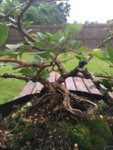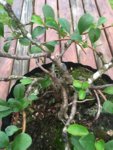RobertB
Chumono
I bought this Japanese quince this spring from a local botanical garden sale. I saw good potential in a future shohin tree. I am currently trying to bring in the branches so i can develop taper and ramification. I pruned it some initially, just to fit on the bench, then trimmed back the new shoots in mid may to a few nodes, then decided to prune again back to the closest green to the base on some branches and back to two nodes on others. I tried to leave some new growth as i know its mid summer and im not sure if this is the best time for heavy pruning on these. I have seen with other quinces that i have that branches can die if they are pruned back to hard or not pruning back to some green.
Question is, should I repot this quince in the fall? I want to work it into a bonsai pot. If I repot in the fall, how much root pruning can i do? Can I remove 2/3 rds of the rootball and place in a shallow grow box? Can I bare root the remaining 1/3rd? Half bare root, like you would a juniper? Any help with this would be greatly appreciated.
The other quince I have that i mentioned of, i repotted this spring, after flower. I mostly just removed loose nursery soil and bunched up the rest of the roots into a grow box. I was trying to be very careful with as I am new to these.
Just after purchased.

I also have successfully taken 4 layers off this plant this season. All are doing well and growing. This is the plant now.

I plant to try and get the finished plant roughly half this size and full and ramified.
Question is, should I repot this quince in the fall? I want to work it into a bonsai pot. If I repot in the fall, how much root pruning can i do? Can I remove 2/3 rds of the rootball and place in a shallow grow box? Can I bare root the remaining 1/3rd? Half bare root, like you would a juniper? Any help with this would be greatly appreciated.
The other quince I have that i mentioned of, i repotted this spring, after flower. I mostly just removed loose nursery soil and bunched up the rest of the roots into a grow box. I was trying to be very careful with as I am new to these.
Just after purchased.

I also have successfully taken 4 layers off this plant this season. All are doing well and growing. This is the plant now.

I plant to try and get the finished plant roughly half this size and full and ramified.


